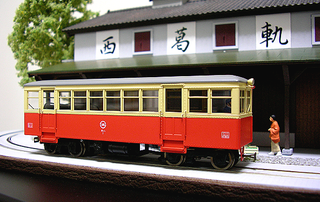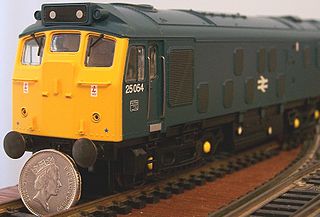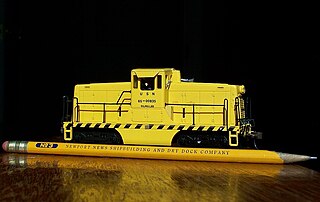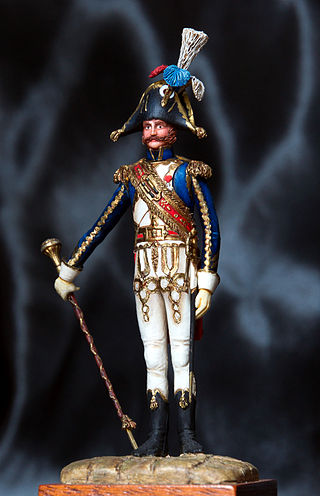
Railway modelling or model railroading is a hobby in which rail transport systems are modelled at a reduced scale.

A model car, or toy car, is a miniature representation of an automobile. Other miniature motor vehicles, such as trucks, buses, or even ATVs, etc. are often included in this general category. Because many miniature vehicles were originally aimed at children as playthings, there is no precise difference between a model car and a toy car, yet the word 'model' implies either assembly required or the accurate rendering of an actual vehicle at smaller scale. The kit building hobby became popular through the 1950s, while the collecting of miniatures by adults started to gain momentum around 1970. Precision-detailed miniatures made specifically for adults are a significant part of the market since the mid-1980s.

G scale or G gauge, also called large scale, is a track gauge for model railways which is often used for outdoor garden railways because of its size and durability. G scale trains use a fixed track gauge of 45 millimetres (1.75 in) to accommodate a range of rail transport modelling scales between narrow gauge (~1:13‒1:19‒1:20), metre gauge (1:22.5), Playmobil trains (~1:24), and standard gauge (~1:29–1:32).

OO gauge or OO scale is the most popular standard gauge model railway standard in the United Kingdom, outside of which it is virtually unknown. OO gauge is one of several 4 mm-scale standards, and the only one to be marketed by major manufacturers. The OO track gauge of 16.5 mm corresponds to prototypical gauge of 4 ft 1+1⁄2 in, rather than 4 ft 8+1⁄2 in standard gauge. However, since the 1960s, other gauges in the same scale have arisen—18.2 mm (EM) and 18.83 mm (Scalefour)—to reflect the desire of some modellers for greater scale accuracy.

A scale model is a physical model that is geometrically similar to an object. Scale models are generally smaller than large prototypes such as vehicles, buildings, or people; but may be larger than small prototypes such as anatomical structures or subatomic particles. Models built to the same scale as the prototype are called mockups.

O scale is a scale commonly used for toy trains and rail transport modelling. Introduced by German toy manufacturer Märklin around 1900, by the 1930s three-rail alternating current O gauge was the most common model railroad scale in the United States and remained so until the early 1960s. In Europe, its popularity declined before World War II due to the introduction of smaller scales.

HO or H0 is a rail transport modelling scale using a 1:87 scale. It is the most popular scale of model railway in the world. The rails are spaced 16.5 millimetres (0.650 in) apart for modelling 1,435 mm standard gauge tracks and trains in HO.

N scale is a popular model railway scale. Depending upon the manufacturer, the scale ranges from 1:148 to 1:160. Effectively the scale is 1:159, 9 mm to 1,435 mm, which is the width of standard gauge railway. However the scale may vary to simulate wide or narrow gauge rail. In all cases, the gauge is 9 mm or 0.354 in. The term N gauge refers to the track dimensions, but in the United Kingdom in particular British N gauge refers to a 1:148 scale with 1:160 track gauge modelling. The terms N scale and N gauge are often inaccurately used interchangeably, as scale is defined as ratio or proportion of the model, and gauge only as a distance between rails. The scale 1:148 defines the rail-to-rail gauge equal to 9 mm exactly, so when calculating the rail or track use 1:160 and for engines and car wheel base use 1:148.
S scale is a model railroad scale modeled at 1:64 scale, S scale track gauge is 22.48 mm (0.885 in). S gauge trains are manufactured in both DC and AC powered varieties. S gauge is not to be confused with toy train standard gauge, a large-scale standard for toy trains in the early part of the 20th century.

A slot car or slotcar is a powered miniature automobile or other vehicle that is guided by a groove or slot in the track on which it runs. A pin or blade extends from the bottom of the car into the slot. Though some slot cars are used to model highway traffic on scenic layouts, the great majority are used in the competitive hobby of slot car racing or slot racing.

In miniature wargaming, players enact simulated battles using scale models called miniature models, which can be anywhere from 2 to 54 mm in height, to represent warriors, vehicles, artillery, buildings, and terrain. These models are colloquially referred to as miniatures or minis.

A model figure is a scale model representing a human, monster or other creature. Human figures may be either a generic figure of a type, a historical personage, or a fictional character.

16 mm to 1 foot or 1:19.05 is a popular scale of model railway in the UK which represents narrow gauge prototypes. The most common gauge for such railways is 32 mm, representing 2 ft gauge prototypes. This scale/gauge combination is sometimes referred to as "SM32" and is often used for model railways that run in gardens, being large enough to easily accommodate live steam models. The next most common gauge is 45 mm, which represents the theoretical non-existent gauge 2 feet 9+3⁄4 inches (857 mm). This gauge is commonly used to portray prototypes between 2 ft 6 in and 3 ft gauge.

Live steam is steam under pressure, obtained by heating water in a boiler. The steam may be used to operate stationary or moving equipment.
1:144 scale is a scale used for some scale models such as micro/mini armor. 1:144 means that the dimensions of the model are 1/144 (0.00694) the dimensions of the original life-sized object; this equates to a scale of 1/2 inch per 6 feet of original dimension. For instance, an airplane 30 feet (9.14 m) in length would be a mere 2.5 inches (63.5 mm) long as a 1:144 scale model.

The 1:64 scale is a traditional scale for models and miniatures, in which one unit on the model represents 64 units on the actual object. It is also known as the "three-sixteenths scale" since 3/16 of an inch represents one foot. An average human is approximately 1+1⁄16 inches (27 mm) tall when represented in 1:64 scale.

1:24 scale is a size for automobile models such as injection-molded plastic model kits or metal die-cast toys, which are built and collected by both children and adults. 1:24 means that a unit of measurement, such as one inch or one centimeter, on the model represents 24 units on the actual object. An example would be one inch of length on a model automobile would represent 24 inches on an actual vehicle. Primarily automobile models are made on this scale, with a few examples of tractor-trailers and other larger equipment. In the United States, there is a minor variation of the 1:24 scale, where many automobile plastic model kits are scaled at 1:25.

SE scale is a designation used by some modellers to describe miniature (model) trains which run on either Gauge 1 track or O gauge track. In the SE scale, 7/8 of an inch equals one foot, which is a ratio of 1:13.7. On 45 mm gauge track this represents real life narrow gauge railways that are 2 ft gauge, while on 32 mm gauge track this represents 18 in railways.

The Aurora Plastics Corporation was an American toy and hobby manufacturing company. It is known primarily for its production of plastic scale models of cars, airplanes, and TV and movie figures in the 1960s. Its principal competition in modeling were various other plastic modeling firms like Revell and Monogram.


















